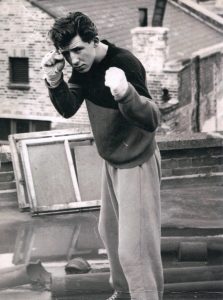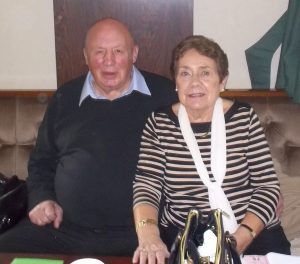
Boxing was something that simply ‘happened’ to George
To hear George Hollister tell it, boxing was seemingly something that simply ‘happened’ to him. Born just prior to the Blitz on 28th June 1940, George confirmed “I had a good upbringing, with my mother and father and my six brothers and two sisters. My brother, Alby, was a good professional boxer. My brother, Ernie, was good as well, and my brother, Lenny, boxed in the army. But Alby was the first man to put Randolph Turpin down. He put him down for a count of eight, and then Alby got beat on points over eight rounds. It was a good performance from Alby. That was on my eighth birthday, in 1948, and that’s how old I was when I started boxing.”
“I started off up Jack Solomons’ gym in Windmill Street. Then I stopped for a while, and then I had quite a few fights for Covent Garden Boxing Club. I couldn’t tell you how many amateur fights I had. My only regret was I didn’t box in the ABAs, but back then I never even thought about doing it. Me, Dixie Dean and Ernie Draper used to go round the different shows together on the tube to see if we could get a fight. One day, the three of us got off the tube at one station, walked under an arch and round again, and got on the same train we’d just got off of! As the years went on, I started working out in the gym doing a bit of training, and my friend, Ernie Fossey, was there. In fact, I think I was his first fighter he trained. We went to Bill Cline’s gym, and that’s where I met Terry Downes and Johnny Berry.”
“Market trading was in my family. We had fruit stalls in Chapel Market and Holloway Road, and I was doing that until I was about 20. Then I went to Smithfield Market and worked down there for 30-odd years. The funny thing was, in those days, I wasn’t even going to fight as a pro. Anyway, Al Phillips turned up at my fruit stall one day and asked me did I want to go pro. So I said ‘Yes, all right,’ and Al Phillips managed me for a while.”
George was 21 when he turned professional, and a year later he married Linda. It was not long before he had a young family to support. “I had to go to work down Smithfield Market, which was pretty heavy work, come home, then try to train, and it just weren’t working out. I had a few fights and I found it hard, to be honest, but it was just to get hold of a few quid. Mind you, I think I got more money out of sparring than I did fighting. I sparred a lot with Terry Downes. He was good to me, a good pal. But, in the sparring, Terry never left you alone. He never took no liberties, but he was on top of you all the time. You never got a rest with him.”
“One day, I went up the gym at the Butchers Arms. Rubin Carter had come over to fight Harry Scott, and they couldn’t get nobody to spar with him. I was just working out up there, and they asked me to spar, so I said ‘Yeah, I’ll have that,’ and I got good money off Rubin. He was a good man and I got £10 a round, which was a lot of money in the sixties. When Rubin came over the second time, he brought me over a head-guard from America. I found him to be a very nice fella. Another time, Al Phillips asked me if I wanted to spar with Emile Griffith at the Thomas A’Becket. It was £20 a round, and my dad said ‘If you don’t want it, son, don’t have it.’ That was the first time my dad ever said that to me. I said ‘For £20 a round, dad, I’ll fight King Kong!’ Emile put me on my backside the first round, and I thought ‘Sod this, I’ve got another two rounds to go yet!”
“I had two nobbins fights with a fella called Louis Samuels. He stopped me in the last round of our first fight in Wolverhampton, and then I stopped him when I boxed him in Brighton. The fight I lost with Louis Samuels was a hard fight, but it was a really good fight, if I say so myself. But nobbins fights were the fights you didn’t really want, because they were so hard. After that fight, I never went straight home. I got down to Smithfield and went in the pub down there, and then I went for some coffee and a bit of breakfast. I looked like I’d been run over, because my eye had come up and it was closed. To be honest, I was too frightened to go home to the wife. I was thinking ‘What’s she gonna say? She’ll make me turn it in when she sees the state of me.’ Anyway, I went to work and my guvnor said to me ‘Georgie, you can’t come to work like that.’ So I said ‘I can’t come to work. I can’t go home. Where am I supposed to go?'”
“Linda always supported my boxing. She’d wash all the blood off my dressing gowns, and things like that. She only ever came once to see me fight, when I stopped a fella called Tommy Lawrence in three rounds at the Majestic. I boxed Tommy Lawrence in my fight before that as well, at Shoreditch. I wasn’t supposed to be fighting that night and I was over the pub with my dad having a drink when they came over. They were a fighter short, so they dragged me out of the pub to fight. I had to borrow Vic Andretti’s gear, his protector, his shorts, and everything, but I don’t know how I got into them. They were very tight. Anyway, I won that one on points.”
The crowning moment of George’s career happened in his fourteenth fight in February 1964. He took on John ‘Young’ McCormack at Seymour Hall, and he stopped the Irishman in the second round to become the first man to beat the future British Light-Heavyweight Champion. George was a natural middleweight, so the size difference was a matter of concern. “Really and truly, I should never have had the fight, because I was weighing 11 stone 2, and he was weighing 11 stone 13. At the weigh-in, my brother said ‘No, you’re not having this. It’s too much weight to give away to fighter of his class.’ So they said ‘Come along to the show and we’ll get you another opponent.’ But, when I got there, it was still John McCormack. Anyway, I stopped him, so that was a bit of luck. But then Jack Solomons made the match again, and I knew nothing about it until I seen the bills hanging on the gate at Smithfield Market, but I never had that one. If McCormack wanted to come in at a lighter weight, okay, but I wasn’t giving 11 pound away, not again.”
George hung up his gloves in 1966, his final ring appearance being a four round stoppage of Mickey Pearce at Shoreditch Town Hall. “Really and truly, I wished I hadn’t stopped boxed so soon, because I turned it in too early, but I found it hard doing a job and boxing at the same time. I had to make up my mind, and Terry Downes half talked me into turning it in anyway. Terry had retired by then, and he came to Joe Bloom’s gym one day when I was training up there, and he said ‘Come on, we’ll go and have a good time for a change.’ So that was it. After that, I had seven years knocking about with Terry, and how the wife ever stood me I don’t know. At one point, we’d been talking about going to Spain. Then one day, Terry phoned me up and he said ‘You ready?’ I said ‘What for?’ He said ‘Come on, we’re going to Spain.’ So I said ‘I can’t, Linda’s out shopping.’ So I left her a note which said ‘Won’t be long, gone to Spain,’ and my family has never forgot it.”
“In the end, I had to leave it alone because I was working and I had my family, and I just couldn’t keep up with Terry, to be honest. Linda was all right. She used to get on well with Terry’s wife, Barbara, and she still does. But I don’t know how the two of them put up with us. Being with Linda was the best thing that ever happened to me, and we’ve got two children and five grandchildren and we’ve very happy with life. As far as boxing goes, for me, the best thing about boxing is all the great people I’ve met. To me, the boxing fraternity are the best of the lot.”

George and Linda, still together after all these years.
my dad tells me about his past, storys about the good old days, about his work with furlong bros roofing ltd and all the other people. he worked with , and good friends like [ when this name come up online i remember the names from my dad] George hollister and terry downs .. i told my dad about it and he had alook and was happy to see george and linda’s picture after all these years . it was good to be able. to put a face to the name after knowing. the name for so long . my dad asked me to say.. he is happy to see you both looking well and wishing them well for the future…….. all the best Ginger Timms
Hi Robert, I’m glad you found the article and you enjoyed it. I will be seeing George at the next London Ex Boxers Meeting on 4th February, and I will pass on your father’s message to George and Linda. Best wishes, Melanie
George and Linda light up our HCEBA meetings every month and are a pleasure to know